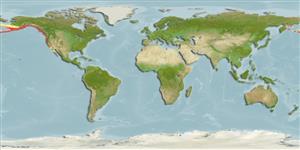Common names from other countries
Issue
Hybridizes with Platichthys stellatus - the hybrid, called Inopsetta ischyra, may be found from the Bering Sea to San Francisco, California, USA.
Environment: milieu / climate zone / depth range / distribution range
Ökologie
seewasser demersal; ozeanodrom (Ref. 51243); tiefenbereich 0 - 550 m (Ref. 6793). Temperate; 61°N - 28°N, 163°E - 114°W
Eastern Pacific: from Russia to Agattu Island, north to Nunivak Island, Alaska, then South to Mexico, Baja California, Mexico.
Length at first maturity / Size / Gewicht / Alter
Maturity: Lm 31.0, range 30 - 32 cm
Max length : 49.0 cm TL Männchen/unbestimmt; (Ref. 6885); 57.0 cm TL (female); common length : 33.0 cm TL Männchen/unbestimmt; (Ref. 56527); max. veröff. Gewicht: 1.5 kg (Ref. 56527); max. veröff. Alter: 22 Jahre (Ref. 55701)
Rückenflossenstacheln (insgesamt) : 0; Rückenflossenweichstrahlen (insgesamt) : 72 - 92; Afterflossenstacheln: 0; Afterflossenweichstrahlen: 45 - 70; Wirbelzahl: 41 - 44. Dorsal origin above middle of upper eye. Pectorals inclined to be pointed.
Adults inhabit sand and mud bottoms (Ref. 4925). Young occur in intertidal areas. Feed on small crustaceans, marine worms, brittle stars and small mollusks (Ref. 6885). Spawning adults make extensive migrations (Ref. 6885).
Vinnikov, K.A., R.C. Thomson and T.A. Munroe, 2018. Revised classification of the righteye flounders (Teleostei: Pleuronectidae) based on multilocus phylogeny with complete taxon sampling. Molecular phylogenetics and evolution, 125:147-162. (Ref. 122998)
IUCN Rote Liste Status (Ref. 130435)
CITES (Ref. 128078)
Not Evaluated
Bedrohung für Menschen
Harmless
Nutzung durch Menschen
Fischereien: kommerziell; Sportfisch: ja
Tools
Zusatzinformationen
Download XML
Internet Quellen
Estimates based on models
Preferred temperature (Ref.
115969): 3.4 - 8.3, mean 5.6 (based on 245 cells).
Phylogenetic diversity index (Ref.
82804): PD
50 = 1.0000 [Uniqueness, from 0.5 = low to 2.0 = high].
Bayesian length-weight: a=0.00575 (0.00358 - 0.00924), b=3.03 (2.89 - 3.17), in cm Total Length, based on LWR estimates for this species & (Sub)family-body (Ref.
93245).
Trophic level (Ref.
69278): 3.4 ±0.46 se; based on food items.
Widerstandsfähigkeit (Ref.
120179): mittel, Verdopplung der Population dauert 1,4 - 4,4 Jahre. (tm=3; tmax=22; K=0.24; Fec=150,000).
Fishing Vulnerability (Ref.
59153): Moderate vulnerability (43 of 100).
Climate Vulnerability (Ref.
125649): Low to moderate vulnerability (27 of 100).
